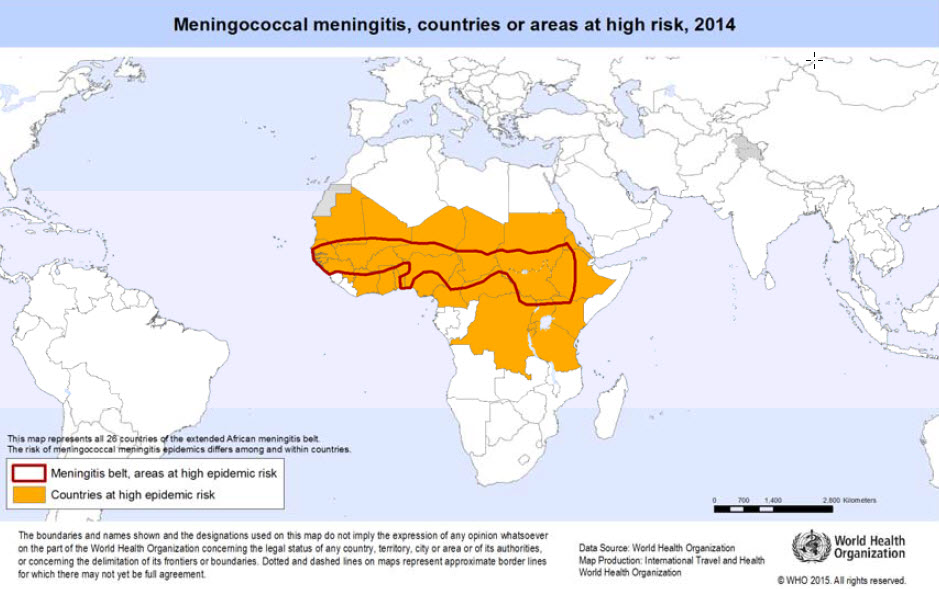Traveller vaccination meningococcal disease
To read more about meningococcal disease, click here.
|
Traveler Vaccination |
Editor-In-Chief: C. Michael Gibson, M.S., M.D. [1];Associate Editor(s)-in-Chief: Seyedmahdi Pahlavani, M.D. [2]
Disease cause
Neisseria meningitidis bacteria, in most cases serogroups A, B and C, Y and X. Serogroup W-135 is an increasing cause of concern.
Transmission
Transmission occurs by direct person-to-person contact and through respiratory droplets from patients or asymptomatic meningococcal carriers. Human beings are the only reservoir.
Nature of the disease
As a rule, endemic disease occurs primarily in children and adolescents, with highest attack rates in infants aged 3–12 months. Meningococcal meningitis has a sudden onset of intense headache, fever, nausea, vomiting, photophobia and stiff neck, plus various neurological signs.
Permanent neurological sequelae are common and the disease is fatal in 5% to 10% of cases. Meningococcal septicaemia is characterized by circulatory collapse, haemorrhagic skin rash and high fatality rate.
Geographical distribution
- Sporadic cases are found worldwide. In temperate zones, most cases occur in the winter months. Localized outbreaks occur in enclosed crowded spaces (e.g. dormitories and military barracks).
- In the meningitis belt of sub-Saharan Africa, large outbreaks take place during the dry season (November to June).
Recent meningococcal outbreaks due to serogroup Y (United States of America), serogroup W-135 (Saudi Arabia and sub-Saharan Africa), and serogroup X (Burkina Faso and Niger), suggest that these serogroups may be gaining in importance.
Risk for travellers
The risk of meningococcal disease in travellers is generally low.
- Those travelling to industrialized countries may be exposed to sporadic cases, mostly of A, B or C. Outbreaks of meningococcal C disease occur in schools, colleges, military barracks and other places where large numbers of adolescents and young adults congregate.
- Travellers to the sub-Saharan meningitis belt may be exposed to outbreaks, most commonly of serogroup A and serogroup W-135 disease, with comparatively very high incidence rates during the dry season.
- Long-term travellers living in close contact with the indigenous population and pilgrims visiting Mecca for the hajj or umrah are at particular risk.
Vaccine
Polysaccharide vaccines
- Internationally marketed meningococcal polysaccharide vaccines are bivalent (A and C), trivalent (A, C and W-135) or tetravalent (A, C, Y and W-135).
- Following one single dose, in most cases subcutaneous, these vaccines provide excellent serogroup-specific protection lasting for 2-4 years in adults and children aged more than 2 years. Meningococcal polysaccharide vaccines are now often replaced by conjugate meningococcal vaccines.
Conjugate meningococcal vaccines
Conjugation of the meningococcal polysaccharide to a protein carrier induces a T-cell-dependent immune response characterized by increased immunogenicity among infants, prolonged duration of protection among older children and adults, and reduced nasopharyngeal carriage of meningococci.
Conjugate meningococcal vaccines are available as monovalent serogroup A and serogroup C vaccines, bivalent serogroups A and C vaccine and tetravalent serogroups A, C, Y and W-135 vaccine.
The conjugate vaccines are serogroup-specific and highly immunogenic (>90%). In contrast to group C polysaccharide vaccines, the group C conjugate vaccine elicits adequate antibody responses and immunological memory even in infants who are vaccinated at 2, 3 and 4 months of age.
- A conjugated serogroup A meningococcal vaccine, which was designed particularly for use in the African meningitis belt, is licensed for single-dose immunization of individuals aged 1–29 years.
- Three tetravalent conjugate vaccines against serogroups A, C, Y and W-135 meningococci are now licensed internationally. They differ in the conjugate carrier protein but all are administered ntramuscularly and show similar immunogenicity. These vaccines are licensed for single-dose immunization of individuals 2–55 years of age.
- Although tetravalent vaccines offer the widest range of protection, they do not protect against meningococci of serogroups B and X, which are common causes of meningococcal disease in some countries.
Required vaccinations
Saudi Arabia demands proof of recent meningococcal vaccination (with the tetravalent vaccine) as a visa requirement for pilgrims and guest workers.
Summary of vaccine data
| Considerations | |
|---|---|
| Type of vaccine | Polysaccharide vaccines that include 2-4 meningococcal serogroups: available as bivalent (A
and C), trivalent (A, C and W-135) and tetravalent (A, C, Y and W-135) vaccines. |
| Conjugate vaccines, available as monovalent (A or C), bivalent (A and C) and tetravalent (A, C, Y and
W-135) vaccines. | |
| Number of doses | For polysaccharide vaccines a single (mostly subcutaneous) dose to individuals aged 2 years or older. One booster may be
required after 3-5 years. |
| For conjugate vaccines primary series of 1-3 intramuscular doses with subsequent boosters. Schedule depends on choice of vaccine, as well as age and immunological
status of the vaccinee. | |
| Contraindications | Severe allergic reaction to vaccine components |
| Adverse reactions | Apart from transient local reactions, all meningococcal vaccines have an excellent safety record. |
| Before departure | Normally about 2 weeks, but may vary with vaccine and vaccinee. |
| Indications |
|
